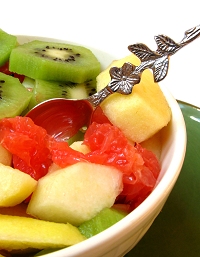Gluten Intolerance Diet
A lot of people are wondering if they are suffering from gluten intolerance symptoms, celiac disease symptoms, or gluten allergy. Let us take a look at the similarities and differences. This will help clear things up once and for all. Then we’ll take a look at what is required for a gluten intolerance diet.
Defining Gluten Intolerance
Gluten Intolerance is a broad term which includes all types of sensitivity or intolerance to gluten…

We must break gluten intolerance down into three separate categories: Celiac Disease, Non-Celiac Gluten Sensitivity, and a Gluten Allergy (also known as Wheat Allergy).
Celiac Disease is an inflammation of the upper part of the small intestines. It is the result of genetic and environmental factors. And one is mainly the consumption of foods that contain gluten. It happens when the proteins in gluten activate your immune system to react excessively to strange antibodies.
Non-Celiac Gluten Sensitivity is difficult to identify. Fundamentally, persons who suffer from this suffer in the same way as people with Celiac Disease, but the blood test which diagnoses celiac disease is negative.
Gluten Allergy or Wheat Allergy, is the reaction of immunoglobulin E. In layman’s terms, this is a traditional allergy where you develop antibodies to an allergen, in this case wheat.
Their symptoms are basically the same which include, persistent constipation, flatulence, passing of foul smelling stools, bloating, cramping, among many others. Never self-diagnose as these are serious conditions, pay a doctor a visit.
What to Avoid on a Gluten Intolerance Diet
A person with gluten intolerance should avoid all foods that contain gluten. This means avoiding wheat, rye, barley, oats and anything made with them. But despite the restriction, a gluten intolerant person can still enjoy a variety of foods.
Any meat products prepared with breadcrumbs or batter, sausages and other processed meats, are not allowed. Unprocessed meat, fish, chicken, and meats that are frozen or canned but with no sauce can be enjoyed.
When it comes to dairy products, malted milk and ice cream in a cone are an absolute no-no but they can eat eggs, full cream milk, low fat milk, evaporated milk, condensed milk, fresh cream. Fresh fruits and vegetables are also good but not the sauced versions.
In cereals and baking products, wheat, wheat bran, barley, oats, porridge, breakfast cereals containing wheat, rye, oats or barley, corn or rice cereals containing malt extract from barley all may contain gluten. Corn flour, soya flour, rice bran, potato flour, breakfast cereals made from corn and rice without malt extract from barley are all safe to eat. Obviously, all bread, cakes and biscuits prepared with flours from a gluten source should be avoided. But you can still munch on those made with corn, rice, potato, soybean and buckwheat.
Beer, stout, and ale are to be avoided but you can still drink tea, coffee, mineral water, wine, spirits and liqueurs.
Enjoying a Gluten Intolerance Diet
Comfort food like spaghetti and lasagna are on the list of not to eat but, despair not, because there are now gluten free pastas. Also, some chocolates and some flavored potato and corn chips are restricted. But you can always eat plain chips and corn chips, popcorn and plain chocolate.
Just because gluten is avoided doesn’t mean you have to avoid every yummy food. Only, make sure that they’re gluten-free. There are companies that offer this type of foods such as 1-2-3 Gluten-Free and Gluten-Free Pantry.
When eating out, ask questions about the preparation of food and what the ingredients are. Most restaurants will provide accommodation to food allergies and the like.
There is no cure, but the disease can be managed by a lifelong gluten free diet. Albeit the fact that your diet is restricted, don’t wallow in the doldrums. Keep in mind that a gluten intolerance diet has benefits that can bring relentless comfort in your life.
